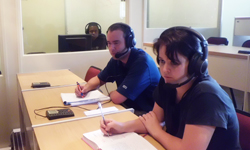Latest News Archive
Please select Category, Year, and then Month to display items
![]()
A decision regarding the possible covering of the MT Steyn statue in front of the Main Building on the Bloemfontein Campus has not been taken yet.
The opportunity for stakeholders to submit oral and written submissions on whether they agree or disagree with the covering of the MT Steyn statue in front of the Main Building on the Bloemfontein Campus until the formal review process on the position of the statue has been concluded, ended on Wednesday 11 April 2018, with 71 written and three oral submissions received by the special task team.
The submissions will be included in a submission to the Free State Provincial Heritage Resources Authority (FSHRA) in order to obtain a permit for the possible covering of the statue. An independent analysis of the submissions is currently underway.
The special task team would like to thank those who submitted oral and written submissions. The university community will be updated on the outcome of the decision by the FDHRA regarding the possible covering of the statue, as well as the results of the independent analysis.
Related articles:
Call for submissions for covering of the MT Steyn statue: Deadline extended to 11 April 2018 (Published on 9 April 2018)
Released by:
Lacea Loader (Director: Communication and Brand Management)
Telephone: +27 51 401 2584 | +27 83 645 2454
Email: news@ufs.ac.za | loaderl@ufs.ac.za
Fax: +27 51 444 6393
“To interpret is more than the ability to have mastered two languages”
2014-03-27
|
 |
It is equally unfair to the accused as the victim when an untrained court interpreter is used in a court case.
In South Africa there are currently a large percentage of interpreters employed by the Department of Justice without any formal training.
While interpreting is in reality a very complex subject, the general acceptance is that everybody who is able speak two languages or more can be an interpreter.
This perception harms interpreting as a profession, as it results in most institutions appointing any multilingual person as an interpreter.
In many cases people are used to interpret into and from their third or fourth language (of which Afrikaans is one). This leads to inaccuracy and the incorrect use of expressions and terminology. Specific cognitive processes also have to be developed and practiced.
The University of the Free State (UFS) has since 2008 trained approximately 200 court interpreters in South Africa. This training includes the theory of interpreting and practical exercises, as well as the development of terminology and a basic knowledge of the legal system in South Africa.
The training provided to court interpreters by the Unit for Language Management and Facilitation, is done in conjunction with the Department of Justice and Constitutional Development and SASSETA (Safety and Security).
Apart from Afrikaans, native speakers of all South African languages are included in the training.
Much attention (rightfully) are given to interpreters who can interpret between the nine African languages and (mostly) English, but in the process the development of interpreters between Afrikaans and English was neglected, as became apparent in the past two weeks during the Oscar Pistorius case.